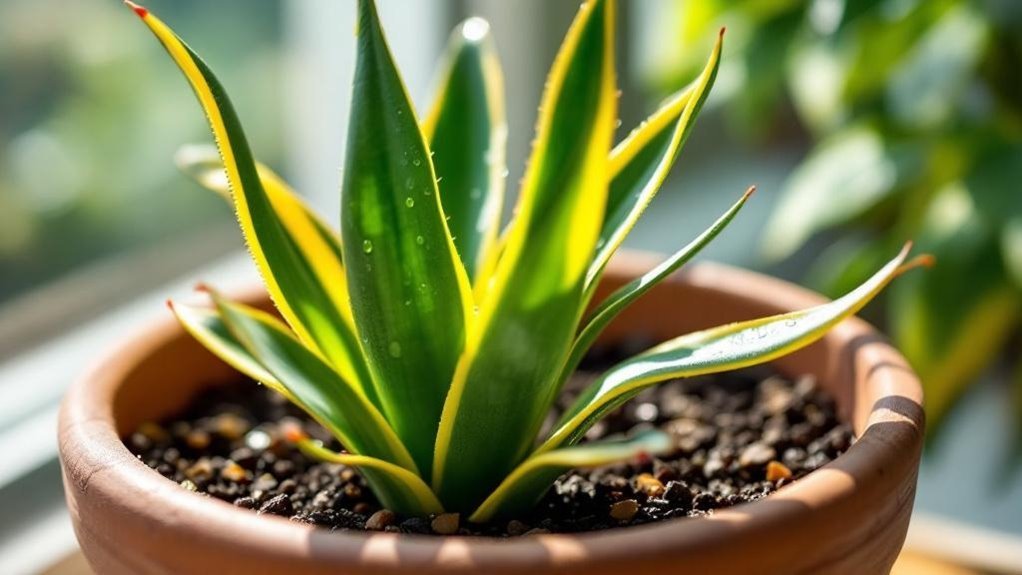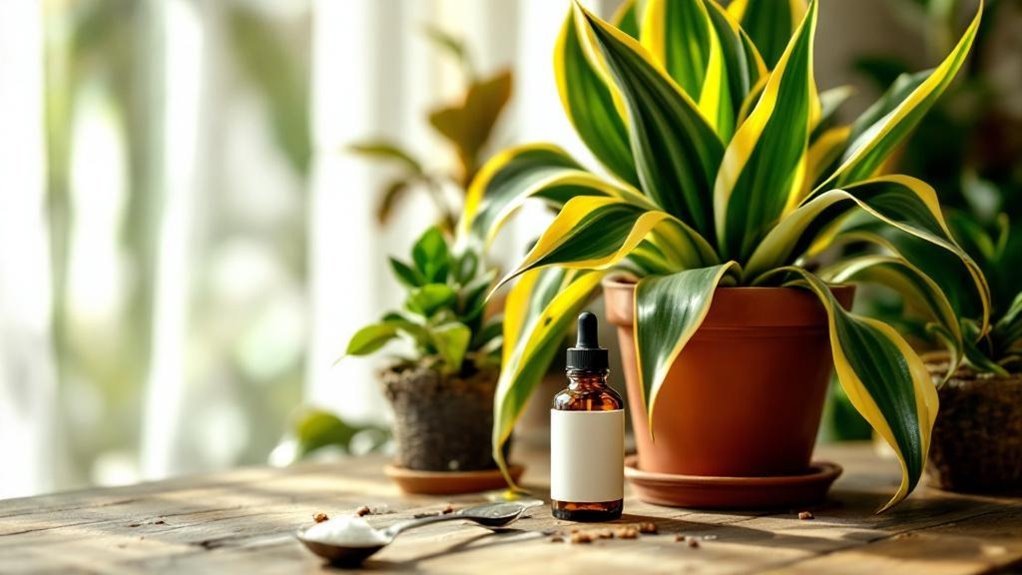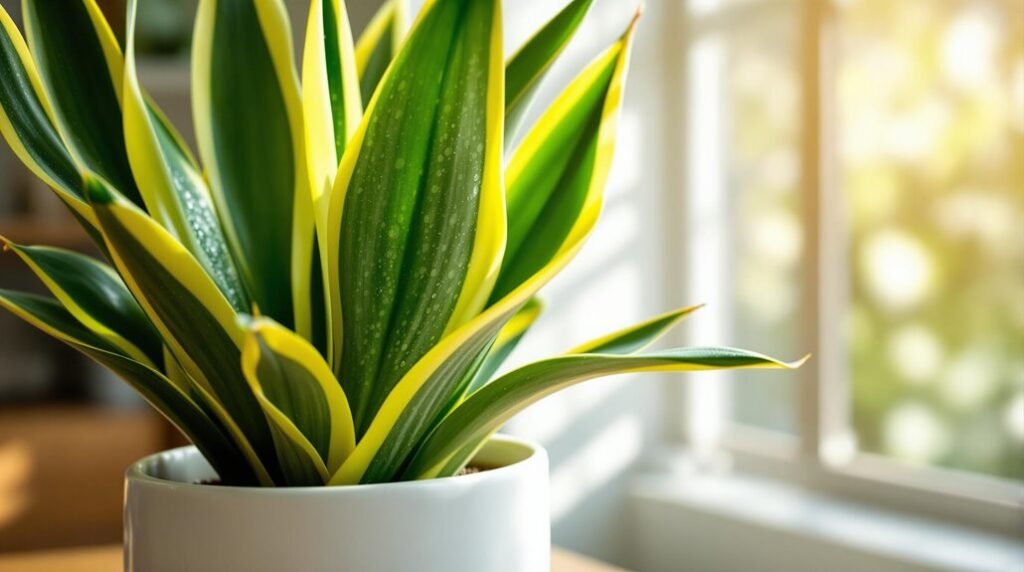Imagine you’ve just brought home a snake plant, a striking addition to your living room that seems almost indestructible. You might think it thrives on neglect, but there’s more to its care than occasional watering. If you want to keep those leaves vibrant and healthy, understanding the right balance of light, water, and soil is crucial. Let’s explore what makes this plant truly foolproof—and what common mistakes to avoid.
Light Requirements
Although snake plants can survive in low light, they thrive when placed in bright, indirect light that encourages strong growth and healthy leaves.
Understanding their light requirements helps you achieve peak growth. While they tolerate low light conditions, you’ll notice slower, less vigorous development.
Knowing their light needs ensures robust growth; low light means slower, less vibrant plants.
For ideal placement, put your snake plant near east-facing or south/west-facing windows. Remember, window size and nearby buildings or trees influence light exposure, so adjust accordingly.
If you want to try acclimatization to direct sunlight, do it gradually to avoid leaf burn, especially if space is limited.
Watering and Humidity
When you water your snake plant, make sure the soil is completely dry to prevent overwatering and root rot. Check moisture levels using a finger test or hygrometer before you water my snake plant, aiming to water every 2-3 weeks during the growing season.
In winter, extend watering intervals to 5-6 weeks. Overwatering leads to yellowing or mushy leaves—signs you should hold off. Always use a pot with a drainage hole to avoid soggy soil and keep roots healthy.
Snake plants tolerate typical household humidity levels well, but occasional misting or a gentle shower can remove dust and promote a plant healthy environment. Meeting these watering needs and monitoring moisture levels will keep your snake plant thriving without the risk of root rot.
Soil and Potting Mix

Since snake plants thrive in well-draining soil, you should choose a loose potting mix designed for succulents or cacti to prevent water retention.
A sandy or loamy soil with slight acidity promotes healthy root growth and guarantees good moisture control.
Use terracotta pots because they allow moisture to evaporate quickly, reducing the risk of overwatering.
Always pick containers with drainage holes to maintain proper drainage and avoid soggy soil conditions that can harm roots.
When repotting every two to three years, check if the roots are root-bound; if so, select a pot only slightly larger to keep your plant snug and supported.
This approach keeps your snake plant healthy and thriving in a well-drained succulent-friendly environment. Additionally, using a potting mix like Espoma Organic Potting Soil Mix can enhance nutrient absorption and root development, ensuring optimal growth for your snake plant.
Temperature and Overwintering
To keep your snake plant healthy, maintain temperatures between 15°C (59°F) and 30°C (86°F) and avoid cold drafts that can stress the plant.
Snake plants don’t tolerate frost, so bring outdoor ones indoors before temperatures drop below 10°C (50°F). During overwintering, place your plant in a warm location to support its dormancy phase.
Cut back on watering to once a month, letting the soil dry out completely to prevent root rot.
Seasonal temperature shifts may require you to reposition your snake plant to maintain ideal conditions.
Fertilizing Practices

Maintaining the right temperature and watering schedule sets the stage for your snake plant’s growth, which is where fertilizing comes into play.
During the growing season, apply a balanced fertilizer at half strength twice a year—typically in spring and mid-summer. Since snake plants aren’t heavy feeders, over-fertilizing can cause salt buildup in the soil and harm your plant.
Revitalizing the soil occasionally helps maintain nutrient availability. Avoid fertilization during dormancy in winter when growth slows.
Common Pests and Problems
While snake plants are generally hardy, they can still fall victim to common pests like mealybugs, spider mites, and fungus gnats.
You’ll want to inspect the plant regularly, looking for white cotton-like clusters from mealybugs, fine webbing from spider mites, or tiny flying fungus gnats around the soil.
Overwatering is a frequent mistake that leads to root rot, often signaled by yellowing leaves and mushy stems. Catching these health issues early is key.
For minor mealybug infestations, gently apply rubbing alcohol with a Q-tip, and for larger problems, neem oil works well to control pests.
Avoid overwatering to prevent root rot, and keep an eye on your snake plant’s overall condition to maintain its health and vibrancy.
Propagation Techniques
Dealing with pests and keeping your snake plant healthy sets the stage for successful propagation.
Maintaining a healthy, pest-free snake plant is essential for successful propagation.
To propagate a snake effectively, you can try division or stem cuttings. Here’s how to get started:
- Separate pups from the original pot and plant in well-drained potting soil mix.
- Use a healthy leaf, cut it into sections, and let the cut ends callus for 5-7 days.
- Place cut leaf sections in water to encourage roots growing; change the water every week.
- Wait until roots develop before transferring cuttings to soil.
- Propagate during spring or summer for the best results with snake plants grown faster.
Flowering and Blooming Tips
If your snake plant starts producing tall spikes of fragrant green and white flowers, you’re witnessing a rare and special event.
Flowering indicates your plant is thriving and often pot-bound, which can encourage blooming. To support this, provide bright, indirect sunlight, crucial for flower production.
Maintain consistent snake plant care by watering moderately and applying fertilizer during the growing season. This guarantees overall plant health, boosting your chances of a bloom.
Avoid frequent re-potting, as disrupting the root system can hinder flowering. Let your snake plant become slightly rootbound to promote flowering naturally.
Frequently Asked Questions
How Do You Keep a Snake Plant Alive Indoors?
You keep a snake plant alive indoors by placing it in bright, indirect light, watering only when soil’s dry, using well-draining soil, maintaining warm temperatures, and fertilizing twice yearly to support healthy growth without overwatering.
Should I Cut the Brown off My Snake Plant?
You can give your snake plant a little “haircut” by trimming brown tips with sanitized scissors. Just cut the dry parts carefully, avoid stressing the plant, and watch its health to keep it thriving.
Where Is the Best Place to Put a Snake Plant in Your House?
You should place your snake plant near an east, south, or west-facing window where it gets bright, indirect light. Avoid cold drafts and direct sunlight to prevent leaf burn, ensuring it thrives comfortably indoors.
How Do I Make Sure My Snake Plant Is Healthy?
You’ll keep your snake plant healthy by giving it bright, indirect sunlight, watering only when dry, fertilizing in spring and summer, checking for pests regularly, and maintaining temperatures between 15°C and 30°C without drafts or heat sources.
Final Thoughts
Caring for your snake plant is like giving a little love to a green friend who rarely asks for much. With just the right light, sparing watering, and a cozy spot, you’ll keep its vibrant leaves thriving. Remember, a little patience goes a long way—this resilient plant rewards you with beauty and air-purifying magic. Treat it well, and your snake plant will become a steadfast companion in your home for years to come.
